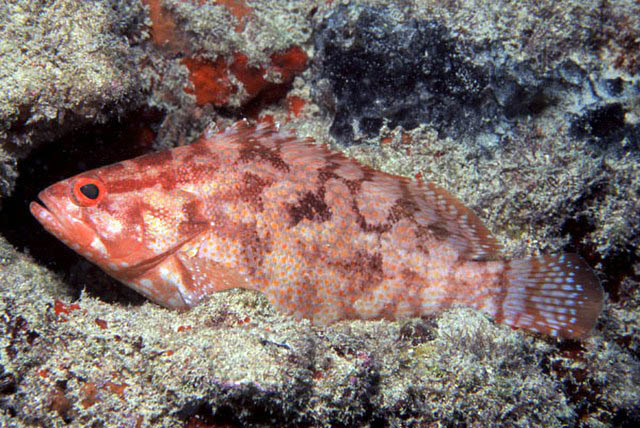| Epinephelidae (Groupers) |
| 33 cm TL (male/unsexed) |
|
reef-associated; marine; depth range 2 - 30 m, non-migratory |
| Western Atlantic: Bermuda, south Florida (USA), Gulf of Mexico, the Bahamas, Cuba, West Indies, Panama, Venezuela, and southward to the state of São Paulo, Brazil. Alphestes afer has recently been re-discovered at São Tomé in the Gulf of Guinea of the Eastern Atlantic. |
|
Dorsal spines (total): 11-11; Dorsal soft rays (total): 17-20; Anal spines: 3-3; Anal soft rays: 9-10. Diagnosis: Body depth is slightly less than head length, depth contained 2.4-3.1 (2.9) in standard length; caudal peduncle depth 7.0-9.0 (8.5) times in SL; eye diameter greater than or equal to snout length and 8.1-15.0 (13) times in SL; snout length 10.1-16.0 (16.0) times in SL; preopercle rounded, posterior edge serrate, with a large antrorse spine at the angle directed downward and forward and usually covered with skin. Gill rakers 5-8 (7) on upper limb, 14-17 (16) on lower limb, 19-25 (23) total, including rudiments. Dorsal fin with XI spines and 17 to 20 (18) soft rays, anal fin with III spines and 9, rarely 10 (10) soft rays; pectoral fins with 16 - 18 (17) rays; caudal fin rounded, with 15 branched rays. Scales are smooth. Lateral-line scales 49-66; lateral scale series 68 – 88 (76). Color in life; head, body, and median fins olivaceous or light brown, irregularly blotched and barred with dark brown. Some individuals are densely spotted with orange; head, body, and all fins often with scattered white spots; body sometimes covered with scattered small black dots; pectoral fins may be orange or yellow with faint dark reticulations (Ref. 57865); Color in market: almost similar to color in life but general body color may fade to a pale drab cream, also spots and reticulations may fade (Ref. 89707). |
| A solitary species (Ref. 26340) occurring in seagrass habitats. Sedentary during the day, hiding in crevices or lying among seaweed, sometimes partly covering itself with sand while lying on its side. Nocturnal feeders of benthic crustaceans. Estimated eggs per fish is from 157512 to 223706 (Ref. 29). Small, colorful group; a sequential hermaphrodite (Ref. 26938). Has been traded as an aquarium fish at Ceará, Brazil (Ref. 49392). |
|
Least Concern (LC); Date assessed: 19 December 2016 Ref. (130435)
|
| reports of ciguatera poisoning |
Source and more info: www.fishbase.org. For personal, classroom, and other internal use only. Not for publication.

